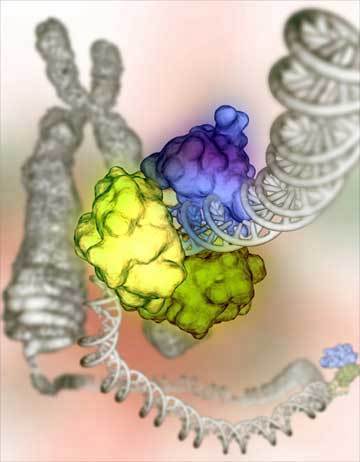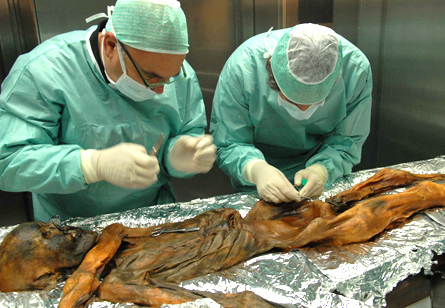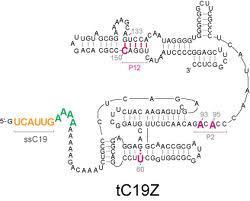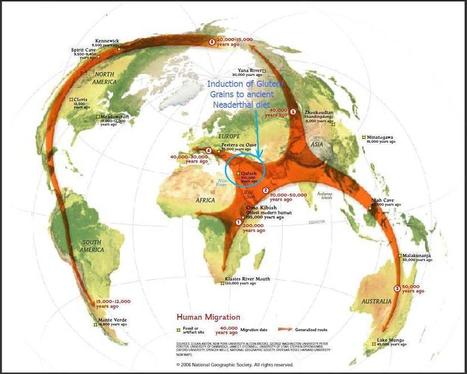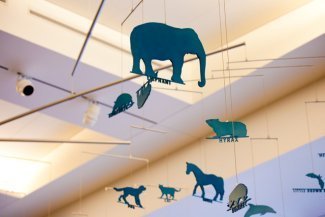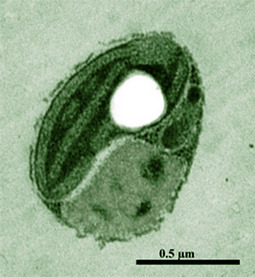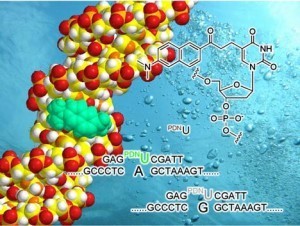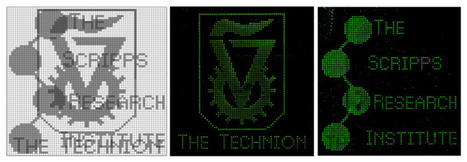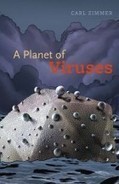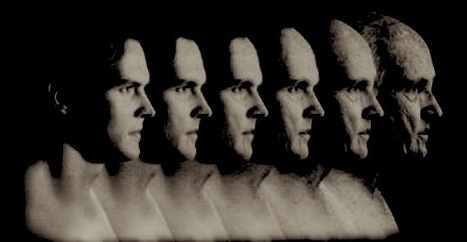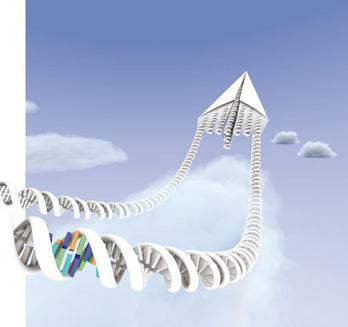 Your new post is loading...

|
Scooped by
Dr. Stefan Gruenwald
March 9, 2012 1:56 PM
|
To visualize the synthesis of biomolecules in living organisms, artificial small molecules can be added to and incorporated by the cell's own biosynthetic machinery. Subsequently, the modified biomolecules containing the artificial units can be selectively labelled with fluorescent substances. Until now, this approach had one major limitation: the substances used for labelling were toxic and caused cell death. Anne Neef, a PhD student from the Institute of Organic Chemistry at the University of Zurich, has developed a new substance that can replace the natural nucleoside thymidine in DNA biosynthesis. This fluorinated nucleoside called "F-ara-Edu" labels DNA with little or no impact on genome function in living cells and even whole animals. "F-ara-Edu" is less toxic than previously reported compounds used for DNA labelling and it can be detected with greater sensitivity. http://tinyurl.com/btwvlh3

|
Scooped by
Dr. Stefan Gruenwald
March 8, 2012 11:01 PM
|
Cancer DNA tests give only a partial picture of the genes driving the disease, according to a study that throws cold water on the idea that scanning may quickly lead to highly effective personalized treatments. Scientists are well aware that different tumors in the same patient, and different parts of those tumors, may harbor a variety of genetic mutations. http://tinyurl.com/6p9wttg

|
Rescooped by
Dr. Stefan Gruenwald
from Science News
February 29, 2012 10:31 AM
|
By peering deeply into the DNA of the mummy known as Ötzi, geneticists have expanded the rap sheet on the 5,300-year-old Iceman: He had brown eyes, brown hair and blood type O, was lactose intolerant and his modern-day relatives live on Corsica and Sardinia.
Via Sakis Koukouvis

|
Scooped by
Dr. Stefan Gruenwald
February 21, 2012 6:13 PM
|
A living plant has been generated from the fruit of a little arctic flower, making it the oldest plant by far that has ever been grown from ancient tissue. The field of ancient DNA has gained credibility as new technologies have allowed researchers to do things like reconstitute the Neandertal genome, Wade says. "The Russian researchers tried to germinate the campion seeds but failed. They then took cells from the placenta, the organ in the fruit that produces the seeds. They thawed out the cells and grew them in culture dishes into whole plants," he adds. "If the ancient campions are the ancestors of the living plants, this family relationship should be evident in their DNA. ... If the claim is true, then scientists should be able to study evolution in real time by comparing the ancient and living campions. Possibly other ancient species can be resurrected from the permafrost, including plants that have long been extinct."

|
Scooped by
Dr. Stefan Gruenwald
February 11, 2012 12:37 PM
|
Nanopore analysis is an emerging technique that involves using a voltage to drive molecules through a nanoscale pore in a membrane between two electrolytes, and monitoring how the ionic current through the nanopore changes as single molecules pass through it. This approach allows charged polymers (including single-stranded DNA, double-stranded DNA and RNA) to be analysed with subnanometre resolution and without the need for labels or amplification. Recent advances suggest that nanopore-based sensors could be competitive with other third-generation DNA sequencing technologies, and may be able to rapidly and reliably sequence the human genome for under $1,000. In this article we review the use of nanopore technology in DNA sequencing, genetics and medical diagnostics.

|
Scooped by
Dr. Stefan Gruenwald
February 9, 2012 7:45 PM
|
It doesn't have a very sexy name, but tC19Z, synthesised in a lab in Cambridge, UK, could be a version of one of the first enzymes that ever existed on our planet - and a clue to how life itself got started. A prominent theory of how life started involves the appearance of a self-replicator - some kind of simple molecule that was capable of making copies of itself without relying on other molecules. The trouble is, if this self-replicating molecule ever did exist, it doesn't any more. The vast majority of organisms around today use DNA to store their genetic information, and DNA does not copy itself - other enzymes do that bit for it. Enter tC19Z. Built by Philipp Holliger and colleagues, it is an RNA enzyme that functions like a self-replicator. RNA is structurally similar to DNA and can also be used to store genetic information. Some RNA molecules can act as enzymes, driving important chemical reactions in cells, but an RNA enzyme that can reliably copy other RNA segments, let alone self-replicate, has proved elusive. Until now, the only known RNA-copying RNA was a molecule called R18, which can only copy RNA segments up to 14 "letters" long, and only works on certain sequences. It's like a word processor that can copy-and-paste "turnip" but not "swede". Holliger, who is based at the MRC Laboratory of Molecular Biology in Cambridge, UK, has now set out to improve R18. He made a vast library of thousands of different versions of the molecule and screened them to see which ones made more copies. After several rounds of copying variants and looking for new improvements, he found several useful tweaks, which he incorporated into his final patchwork enzyme, tC19Z. In reality, tC19Z can reliably copy RNA sequences up to 95 letters long, a near-sevenfold increase on R18. Its performance varies depending on the sequence it's copying, but it is much less picky than R18. Holliger compares R18 to a sports car that works only on a smooth, flat road. "We have fitted a four-wheel drive, so it can go off-road a bit," he says. Crucially, tC19Z can copy pieces of RNA that are almost half as long (48 per cent) as itself. If an RNA enzyme is to copy itself, it has to be able to copy sequences as long as itself, and tC19Z is closing in on that goal. In a neat twist, Holliger's team also showed that tC19Z can make copies of another RNA enzyme, which then worked correctly. That suggests that, once the first self-replicating RNA had appeared, it would have been able to surround itself with additional molecular equipment, kick-starting the evolution of more complex life.

|
Scooped by
Dr. Stefan Gruenwald
February 5, 2012 12:12 PM
|
Where do you really come from? And how did you get to where you live today? DNA studies suggest that all humans today descend from a group of African ancestors who—about 60,000 years ago—began a remarkable journey. The Genographic Project (http://genographic.nationalgeographic.com) is seeking to chart new knowledge about the migratory history of the human species by using sophisticated laboratory and computer analysis of DNA contributed by hundreds of thousands of people from around the world. In this unprecedented and of real-time research effort, the Genographic Project is closing the gaps of what science knows today about humankind's ancient migration stories.

|
Scooped by
Dr. Stefan Gruenwald
February 5, 2012 11:49 AM
|
In many ways, life is like a computer. An organism's genome is the software that tells the cellular and molecular machinery—the hardware—what to do. But instead of electronic circuitry, life relies on biochemical circuitry—complex networks of reactions and pathways that enable organisms to function. Now, researchers at the California Institute of Technology (Caltech) have built the most complex biochemical circuit ever created from scratch, made with DNA-based devices in a test tube that are analogous to the electronic transistors on a computer chip. NEW LINK

|
Rescooped by
Dr. Stefan Gruenwald
from BS2040: Bioinformatics
February 4, 2012 11:49 AM
|
Roughly 17,000 registered players of the DNA sequencing game Phylo have helped solve more than 350,000 problems since November 2010. Read this blog post by Elizabeth Armstrong Moore on Health Tech.
Via Dr Richard Badge

|
Scooped by
Dr. Stefan Gruenwald
February 2, 2012 11:59 AM
|
Do the principles of quantum mechanics apply to biological systems? Until now, both biologists and physicists have considered quantum systems and biological molecules to be like apples and oranges. Do the principles of quantum mechanics apply to biological systems? Newest research conducted in Germany, which appeared recently in Science, shows that a biological molecule -- DNA -- can discern between certain quantum states like spin.

|
Scooped by
Dr. Stefan Gruenwald
February 1, 2012 7:09 PM
|
Researchers recently compared 29 genomes of different mammals in an effort to understand our own genomic mysteries. By looking across species, they have cast new light on the molecular components of all life and have taken an important step toward decrypting the information locked in our own DNA.

|
Scooped by
Dr. Stefan Gruenwald
February 1, 2012 2:02 PM
|
DNA barcoding is a technique for characterizing species of organisms using a short DNA sequence from a standard and agreed-upon position in the genome. DNA barcode sequences are very short relative to the entire genome and they can be obtained reasonably quickly and cheaply. The cytochrome c oxidase subunit 1 mitochondrial region (COI) is emerging as the standard barcode region for higher animals. It is 648 nucleotide base pairs long in most groups, a very short sequence relative to 3 billion base pairs in the human genome, for example.

|
Scooped by
Dr. Stefan Gruenwald
February 1, 2012 12:21 PM
|
Recent research has shown that the transcription and translation of genes, or even the presence of DNA in the cell, are not necessary for the daily ("circadian") rhythms to occur. This article gives a nice summary about the history of circadian rhythms discoveries.
|

|
Scooped by
Dr. Stefan Gruenwald
March 9, 2012 11:05 AM
|
A team of scientists have discovered a previously unidentified type of small circular DNA molecule occurring outside the chromosomes in mouse and human cells. The circular DNA is 200-400 base pairs in length and consists of non-repeating sequences. The new type of extra-chromosomal circular DNA (eccDNA) has been dubbed microDNA. Unlike other forms of eccDNA, in microDNA the sequences of base pairs are non-repetitive and are usually found associated with particular genes. This suggests they may be produced by micro-deletions of small sections of the chromosomal DNA. http://tinyurl.com/8ylslpa

|
Scooped by
Dr. Stefan Gruenwald
March 5, 2012 4:34 PM
|
Scientists at The University of Nottingham have used a revolutionary new DNA-reading technology for a research project that could lead to correct genetic diagnosis for muscle-wasting diseases.

|
Scooped by
Dr. Stefan Gruenwald
February 28, 2012 12:52 PM
|
Medicine has certainly progressed in the past 50 years, but the day when tricorders diagnose every ailment instantly and treatments are tailored to our DNA seems as far off as ever. Eric Topol is trying to bridge that gap. In his new book, The Creative Destruction of Medicine, Topol—the chief academic officer at Scripps Health—calls on patients to demand true digital medicine now. Dr. Topol talks about genetics, gadgets, and his vision of a Khan Academy for doctors. http://tinyurl.com/7fel847

|
Scooped by
Dr. Stefan Gruenwald
February 17, 2012 5:00 PM
|
It may look like an ordinary USB memory stick, but a little gadget that can sequence DNA while plugged into your laptop could have far-reaching effects on medicine and genetic research. The UK firm Oxford Nanopore built the device, called MinION, and claims it can sequence simple genomes – like those of some viruses and bacteria – in a matter of seconds. More complex genomes would take longer, but MinION could also be useful for obtaining quick results in sequencing DNA from cells in a biopsy to look for cancer, for example, or to determine the genetic identity of bone fragments at an archaeological dig. The company demonstrated today at the Advances in Genome Biology and Technology (AGBT) conference in Marco Island, Florida, that MinION has sequenced a simple virus called Phi X, which contains 5000 genetic base pairs.

|
Scooped by
Dr. Stefan Gruenwald
February 11, 2012 12:13 PM
|
Children’s Hospital Boston recently announced a $25,000 competition for the development of an interpretation and communication system that can deliver genomic information from the lab to physicians and patients. As the cost of genome sequencing continues to fall and may break the $1,000 barrier soon, the issue is no longer about acquiring genetic data but about what all the data means. Scientists around the world have been making progress interpreting the molecular language of DNA but, as the Human Genome Project revealed, the human genome contains at least 25,000 genes, so research can be slow going. Furthermore, what information is obtained and published in journals has a hard time finding its way into practices for physicians to understand and apply toward patient care.

|
Scooped by
Dr. Stefan Gruenwald
February 8, 2012 11:18 AM
|
Scientists have developed a “biological computer” capable of deciphering images encrypted on DNA chips. As a proof of concept, the scientists encrypted the Scripps Research and Technion logos on a single DNA chip and, using software, decrypted the separate fluorescent images.

|
Scooped by
Dr. Stefan Gruenwald
February 5, 2012 12:02 PM
|
Viruses are the smallest living things known to science, and yet they hold the entire planet in their sway. We’re most familiar with the viruses that give us colds or the flu, but viruses also cause a vast range of other diseases, including one disorder that makes people sprout branch-like growths as if they were trees. Viruses have been a part of our lives for so long, in fact, that we are actually part virus: the human genome contains more DNA from viruses than our own genes. Meanwhile, scientists are discovering viruses everywhere they look: in the soil, in the ocean, even in deep caves miles underground. The world’s oceans alone are home to an astonishing 1,000,000,000,000,000,000,000,000,000,000 viruses

|
Scooped by
Dr. Stefan Gruenwald
February 5, 2012 11:20 AM
|
While genes partly shape how our body ages, environmental influences change our DNA as we age - methylation patterns shift as we grow older and contribute to aging-related disease. Using saliva samples contributed by 34 pairs of identical male twins between the ages of 21 and 55, UCLA researchers scoured the men's genomes and identified 88 sites on the DNA that strongly correlated methylation to age. They replicated their findings in a general population of 31 men and 29 women between the ages of 18 and 70.

|
Rescooped by
Dr. Stefan Gruenwald
from Science News
February 4, 2012 9:58 AM
|
With the relentless rise of DNA nanotechnology's popularity, Emma Davies explores the role chemistry has played in its success. As a supramolecular chemist, Hanadi Sleiman found herself strongly drawn to manmade DNA structures. 'We think of DNA as the most programmable structure there is. I thought - if it is - let me try to incorporate it into regular supramolecular structures,' says the professor at McGill University, Montreal, Canada. She hasn't looked back. 'What is really beautiful about DNA structures is the fact that you can control every single aspect of them,' she exclaims.
Via Sakis Koukouvis

|
Scooped by
Dr. Stefan Gruenwald
February 2, 2012 11:43 AM
|
For the last decade cancer research has been guided by a common vision of how a single cell, outcompeting its neighbors, evolves into a malignant tumor. But recent discoveries have been complicating the picture with tangles of new detail. Cancer appears to be even more willful and calculating than previously imagined. Researchers are finding clues that pseudogenes lurking within the so-called "junk" DNA making up over 90% of the total genome play a very important role in cancer.

|
Scooped by
Dr. Stefan Gruenwald
February 1, 2012 3:29 PM
|
For years, scientists believed the vast phenotypic differences between humans and chimpanzees would be easily explained by their genes -- the two species must have significantly different genetic makeups. However, when their genomes were later sequenced, researchers were surprised to learn that the DNA sequences of human and chimpanzee genes are nearly identical. The difference lies in the insertion and deletion of large pieces of DNA near genes which are highly variable between humans and chimpanzees and may account for major differences between the two species.

|
Scooped by
Dr. Stefan Gruenwald
February 1, 2012 1:57 PM
|
The entire DNA sequence of a woman who lived to 115 has been pieced together by scientists. The woman, who was the oldest in the world at the time of her death, had the mind of someone decades younger and no signs of dementia. She appeared to have some rare genetic changes in her DNA, some of them might have protected her against dementia and other diseases of later life. The woman was born prematurely and was not expected to survive. But she lived a long and healthy life, and entered a care home at the age of 105. She eventually died from a stomach tumor, having been treated for breast cancer at the age of 100.
|



 Your new post is loading...
Your new post is loading...



